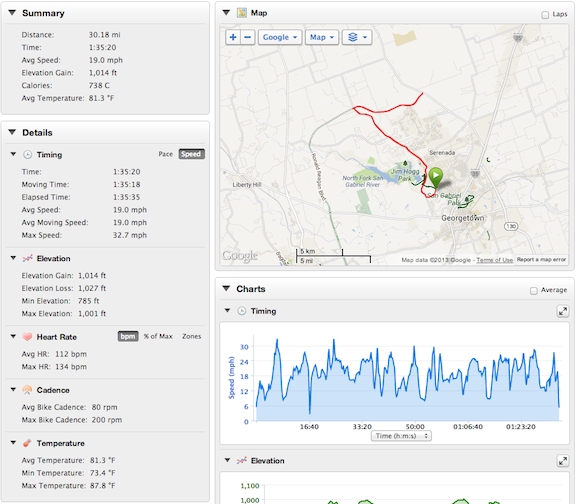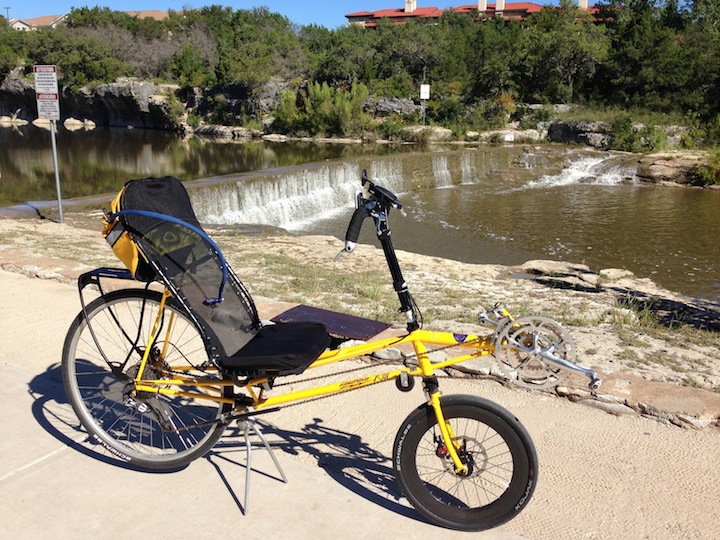
Beautiful day for an easy recovery ride to the Blue Hole today.
http://connect.garmin.com/activity/380238674
Put the fairing back on the bike for tomorrows ride.
Removed the dual kickstand.

Beautiful day for an easy recovery ride to the Blue Hole today.
http://connect.garmin.com/activity/380238674
Put the fairing back on the bike for tomorrows ride.
Removed the dual kickstand.
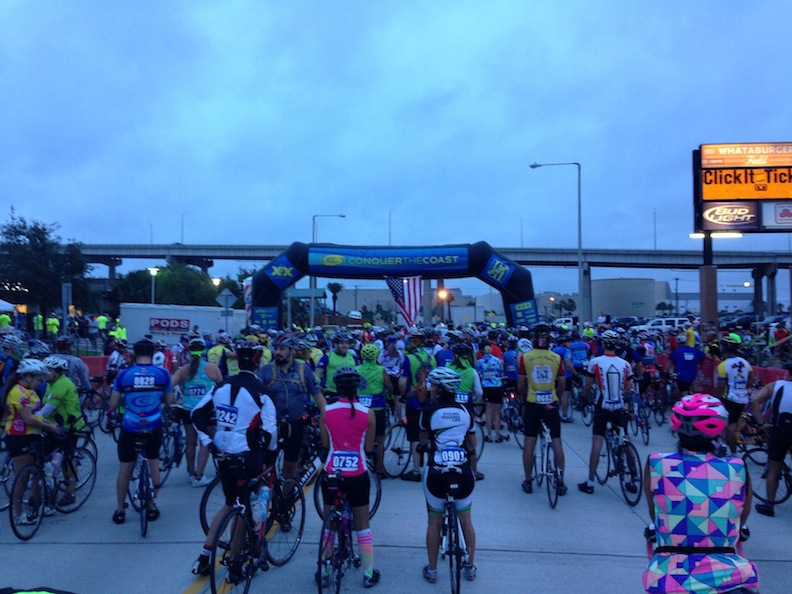
Late in the week the weather was expected to be heavy rain for the Saturday morning ride. But, come ride day the rain was mostly gone for the start of the ride. Robyn and I got the ride early. She was doing the 25 mile route on her new lime green Expedition Catrike. I opted for the 65 mile around the bay route. About 1,500 people lined up for the start and I spent some time before the start riding around the parking lot talking with other riders.
I met up with TWO other P-38 riders in the parking lot - both local to the Houston area and used their P-38s to commute daily.
The first 12 miles were a tough pound into a headwind of 20 mph gusting to 30 mph. As time went on the winds increased to 25 mph gusting to 35 mph. The decision late in the week to remove the fairing from the F-40 and ride the P-38 was the correct one.
The ride started out and almost immediately it was climb over the Harbor bridge directly into the 20 mph headwind. The start was organized into three waves for the 65 mile ride. The first wave was for riders expected to do 20+ mph, the second wave for riders expected to do 15-20 mph and then the rest of the riders in the last wave. I started at the front of the second wave (15-20 mph) and I could see that a lot of the riders in the first group did not really belong there (based upon my own prior health history I know that there are certain physiques that do not lend themselves to 20 mph average for 65 miles).
The Harbor bridge was an 8 percent grade for a half mile. I probably passed 30 percent of the first wave going up the bridge and then the next 12 miles were into the 20 mph headwind. The P-38 allowed me to better penetrate the headwind and again I passed many uprights in the first 12 miles. Of course it helped that the two other P-38s eventually caught me around mile marker 4 and we formed a rotating pace-line into the wind for about 8 miles. I really need to work on my pace-line abilities because I kept getting dropped off the back and had to work extra hard to re-acquire. It was really cool riding with two other P-38s. When passing uprights they would yell when the second P-38 passed them and then scream ‘THREE OF THEM’ when the third passed.
Finally after 28 miles we reached the Port Aransas ferry. They held the ferry for 15 minutes while it loaded up with bicycles and I think all the recumbents were on the same crossing as myself: three P-38s, a Carbon Aero 2.0 and an original small-wheeled Carbent. I wish I’d have taken pictures of the other recumbents.
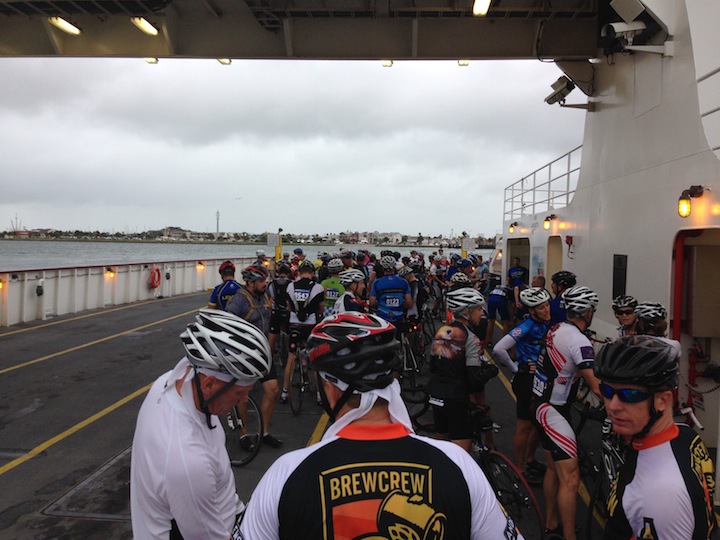
Once off the ferry, and headed south down Mustang Island, the wind became a quartering tailwind and the ride was a blast! For an hour, with the help of the tail wind, I averaged around 23 mph. Life was pretty darn good.
####The Good Life - Speeding down Mustang Island @ 23 mph####
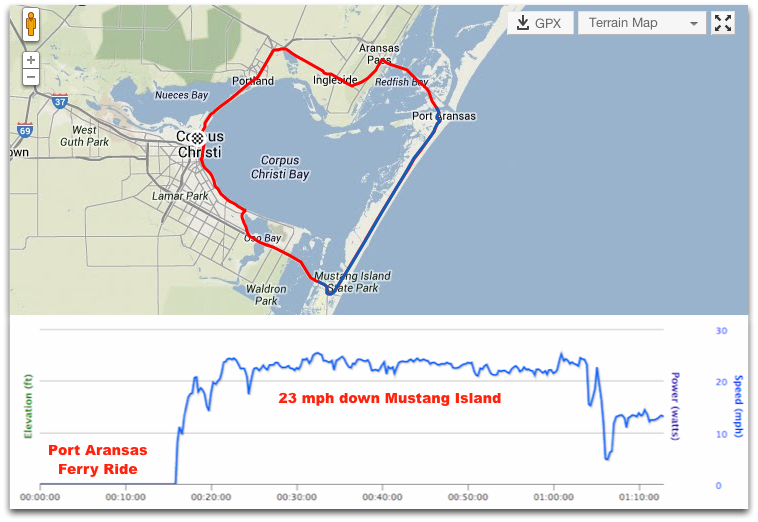
The good life ended at mile marker 48 where I came to the bridge at the southern end of Mustang Island. Again another 8 percent grade for 1/3 mile with a quarting headwind that had increased by now to 25 mph gusting to 35. The deep-v rim on the front of my bike was getting yanked all over the place and I had to maintain a death grip on the handle bars. At the top of the bridge it started raining - pelting and stinging like mad. I rode the brakes all the way down the other side of the bridge to keep under 10 mph just so that I could keep control of the bike. The rest of the ride over the 3 mile causeway was brutal. The hard rain, the 35 mph gusting wind picking up every little piece of sand and flinging it against me, the front wheel wanting to go every which way. I was pretty darn glad to make it back to land where there were some buildings to shield the wind every now and then.
Now it was another 14 miles into the headwind north back up the coast to Corpus Christi. The ride along Ocean Dr was beautiful (even if very windy).
Riding the last 12 miles along Ocean Dr with the headwind of 25 mph gusting to 35 mph I started to become concerned about Robyn because I knew that she also had to conquer this section of the ride on her Expedition Catrike. It was a real struggle for me on this section because I was already exhasted from the first 53 miles.
Three miles from the finish I get a flat front tire. Bummer. I was already so exhasted that it took me 20 minutes to change the tire. I’ve had two flats now in the last two weeks since I’ve changed the tires from Marathon Pluses to Kojaks. I think I’m going to try some Stan’s NoTubes sealant to see if I can stop the flats.
Riding through the finish gate I was very releaved to see Robyn having successfully completed the dificult 25 mile ride in the fierce wind.
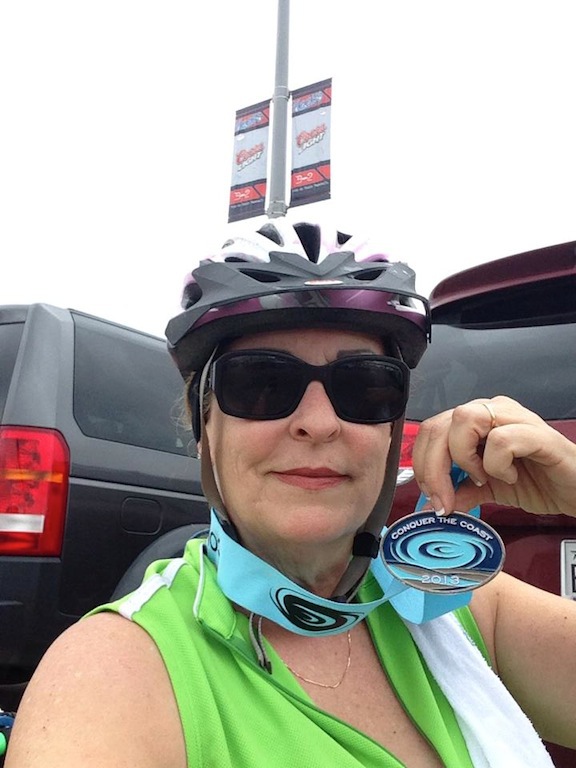
I noticed there is a difference between men and women in finish photographs. I have dirt and sand all over me. My bike jersey is all grease from changing the tire. I’m sitting in a chair because I can hardly move. Robyn on the other hand looks like she’s ready to go out for a night on the town. Hmmm, me thinks she may have primped before taking her photo?
Post ride celebration / recovery. That was one tough ride. I wanted an experience. I got it.
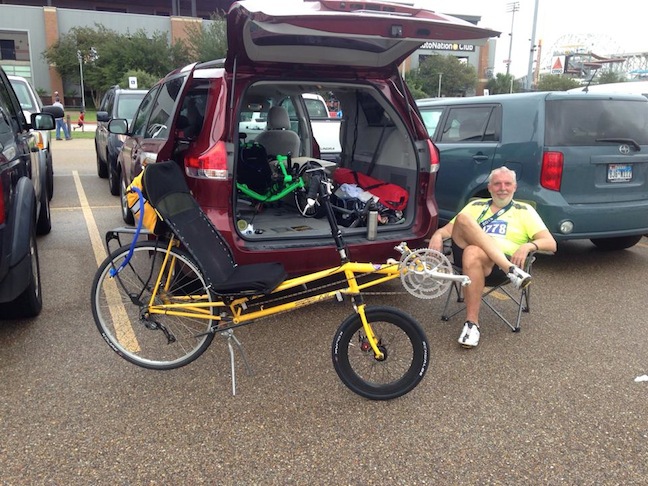
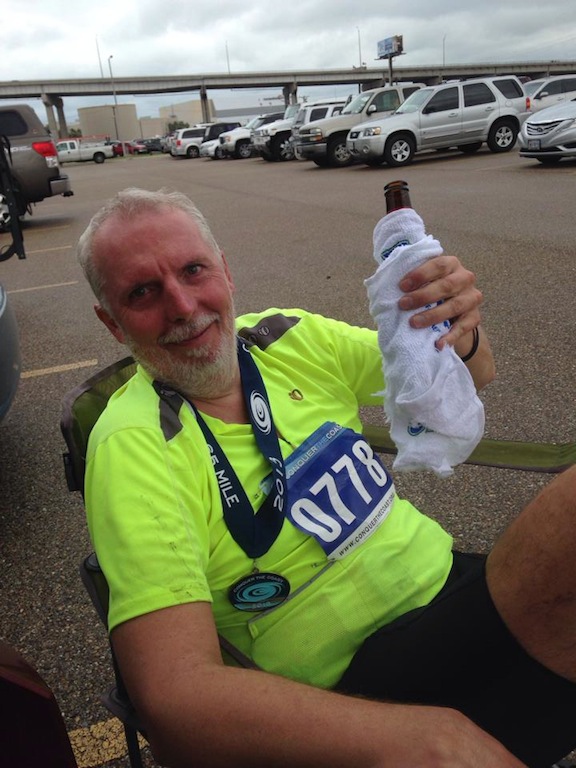
65.8 miles, four hours and ten minutes ride time. Only two breaks: 20 minutes on the ferry and 23 minutes changing the tire.
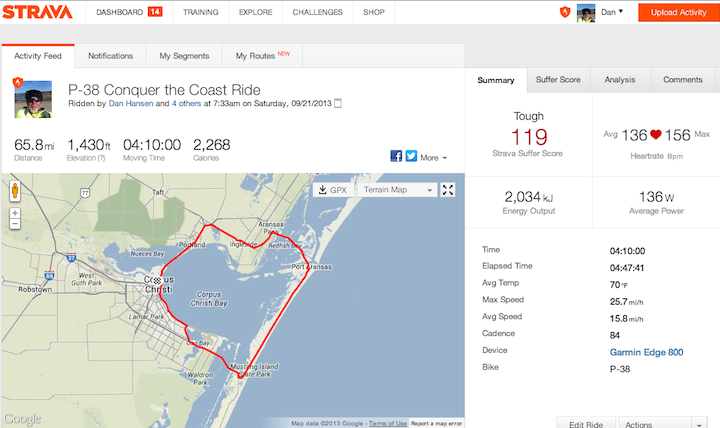

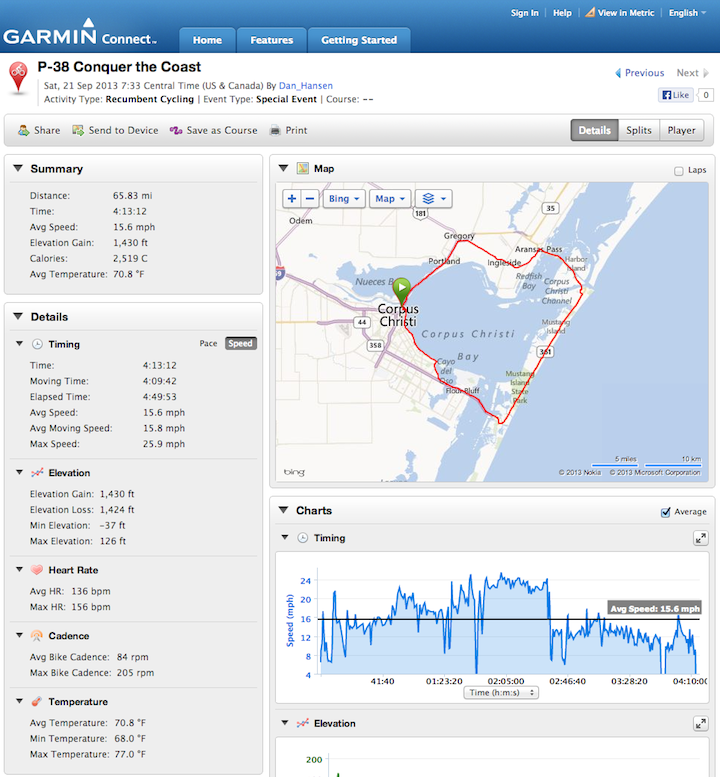
Of course by the next morning the weather had cleared - no wind, no clouds - just a beautiful morning sitting on the balcony having some coffee looking out over the bay.
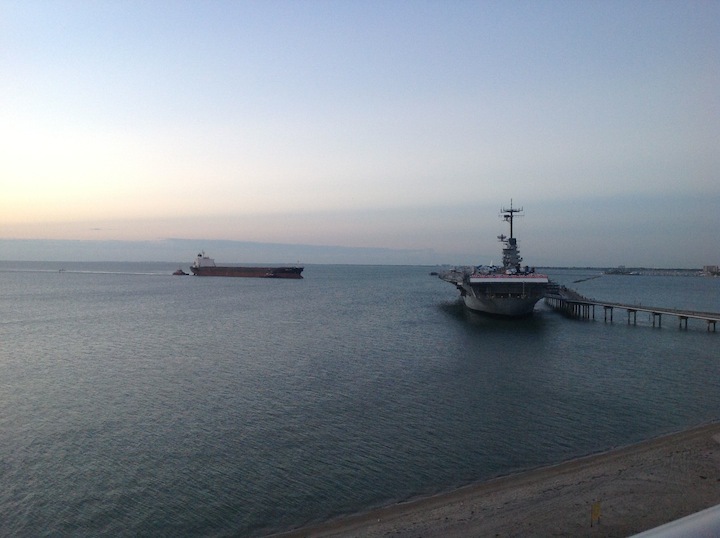
I’ve experimented with several ways to remove the fairing from the F-40 turning it into a P-38. These are my latest thoughts.
Taking the fairing off only requires about 10 minutes. Of course if you also take lots of pictures it can take a lot longer.
Start out with the spandex fully zipped up:
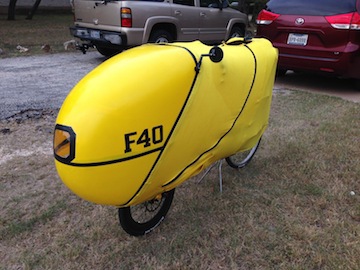
|
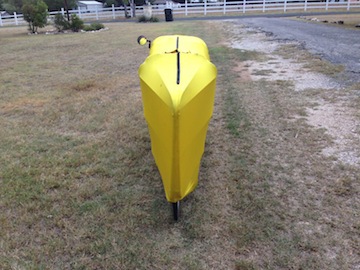
|
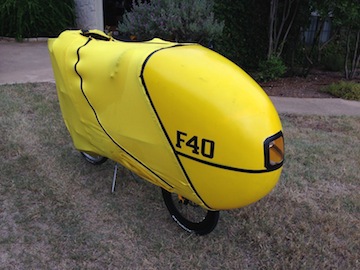
|
Next we are going to just peel the spandex off starting from the front and then proceed towards the back.
First un-velcro the two front sides:
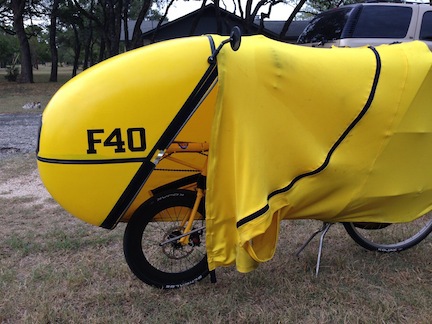
|
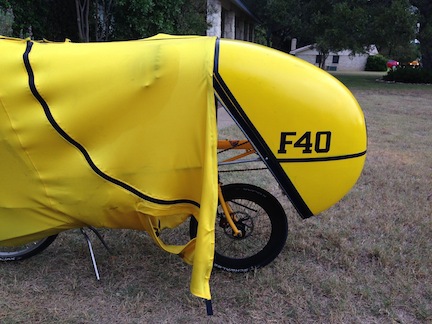
|
Unzip the bottom section:

|
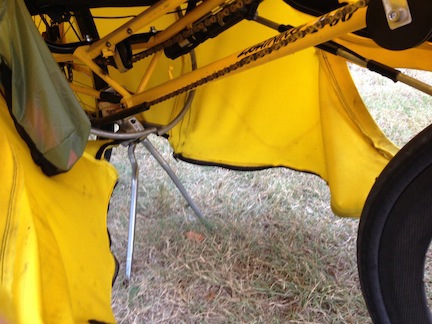
|
Now unvelcro and peel back the top spandex from the front fairing:
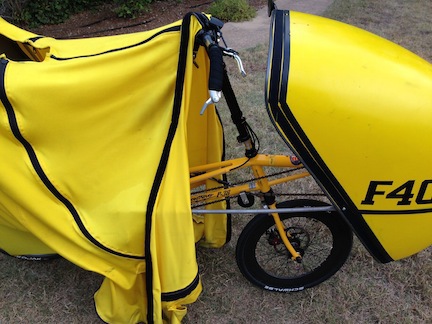
|
Keep gently peeling back the spandex until it is laying on the ground under the rear wheel.
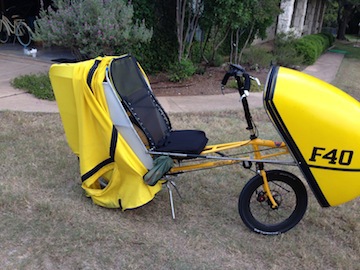
|
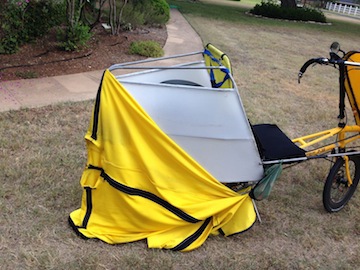
|
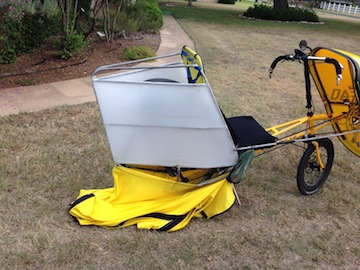
|
Unvelcro the spandex from the tail frame bottom:

|
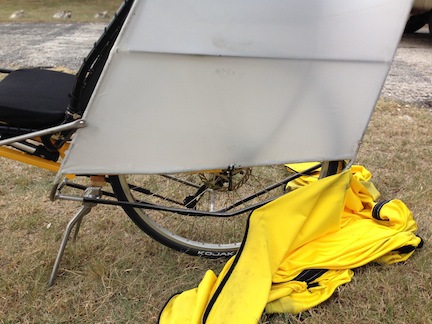
|
Put the spandex somewhere out of the way. Now the two things left to remove are the front fairing and the rear tail frame.
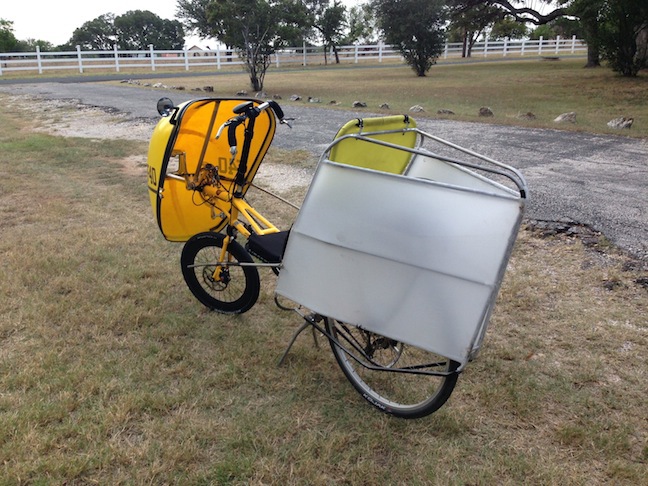
|
Tools you are going to need to take the fairing off:

|
The front fairing is held on by two tie-wraps and the right side strut. The left side strut is spring-loaded attached so that you can enter and exit the F-40 easier.
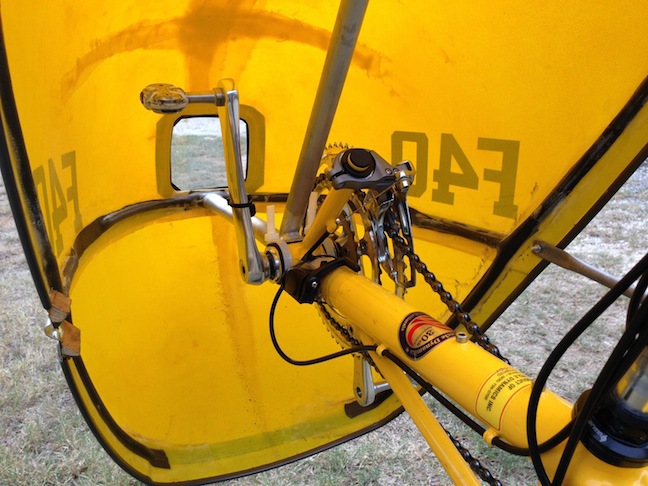
|
Disconnect the right side strut from the front fairing and snip the two tie-wraps at the bottom of the bottom-bracket.
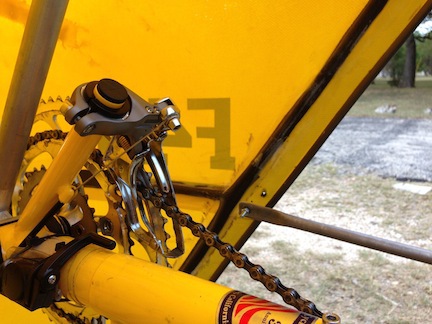
|
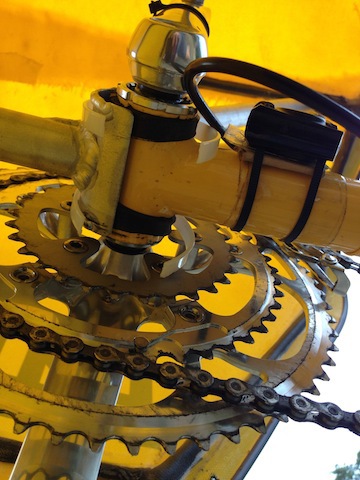
|
You are now ready to remove the front fairing. Never pull or push on the fairing itself. Only pull and push on the inside tubing structure. When removing the fairing I lay on the ground and brace my elbow against the front fork stem so that I wiggle/push the inside tubing with both hands. Gently wiggle off the front fairing.

|
When I put the front fairing on I make sure to grease the rubber damper. When removing the fairing I make sure to remove the rubber damper from the front of the bike and store it inside the fairing.
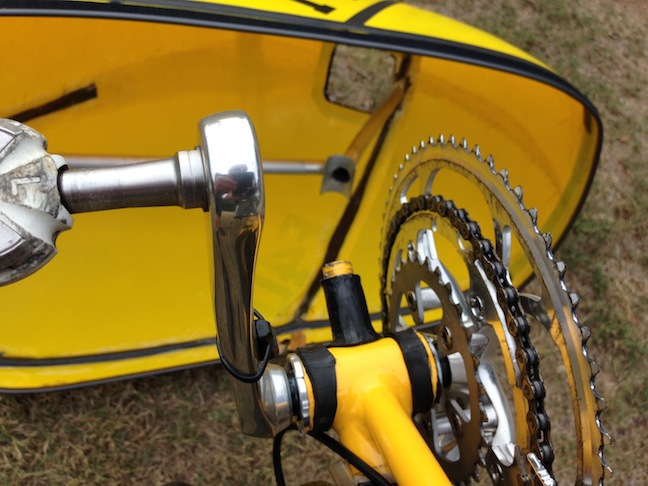
|
With the front fairing off the only thing left if the rear tail frame which is held on at 6 attachment points:
Remove the two side struts.
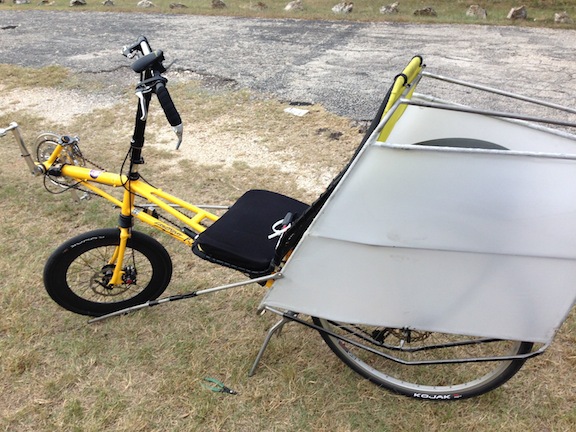
|
I keep the nuts and bolts attached to the struts so that I can find them again later when I want to put the fairing back on.
The right side strut has my feed bags attached. When riding I just reach down with my right hand and fish around in the bag for stuff. The other bag is for my cell phone so that I can easily reach it to take pictures.
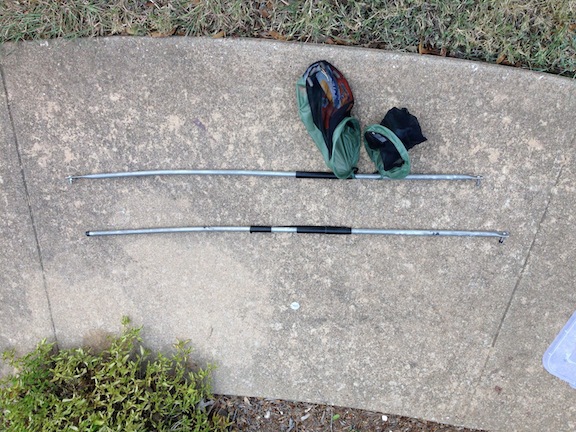
|
Now remove the other 4 nut/bolts to take the rear tail frame off.
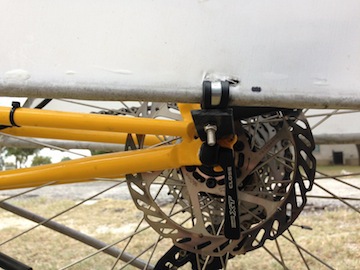
|
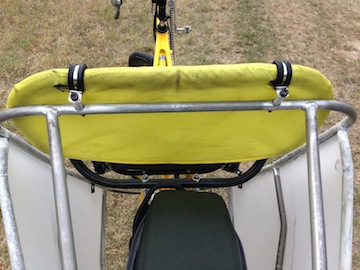
|
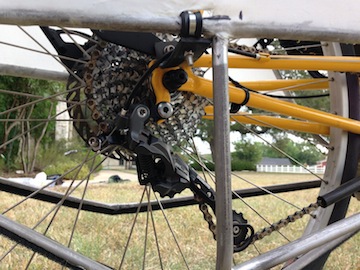
|
| 1 on the left dropout | 2 at the top of the seat | 1 on the right dropout |
I also remove the rack top bag because I use a seat back bag when riding the P-38
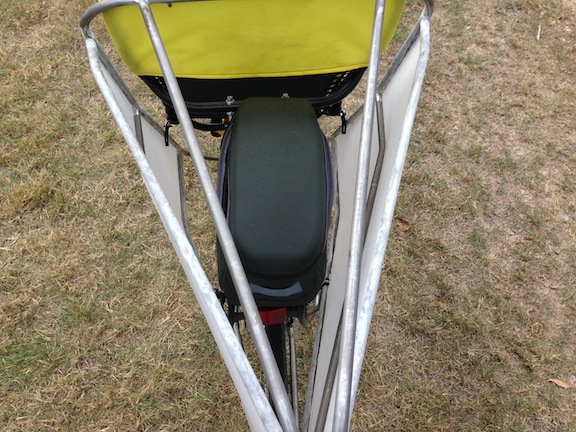
|
We now have a P-38
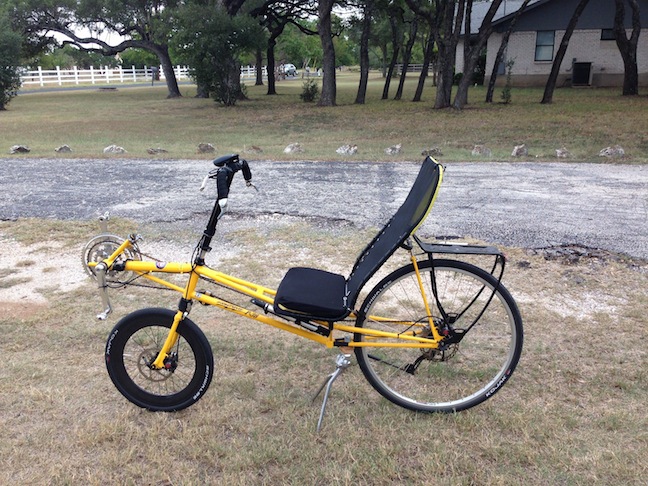
|
I move my stuff from the F-40 rack top bag to the P-38 seat back bag.
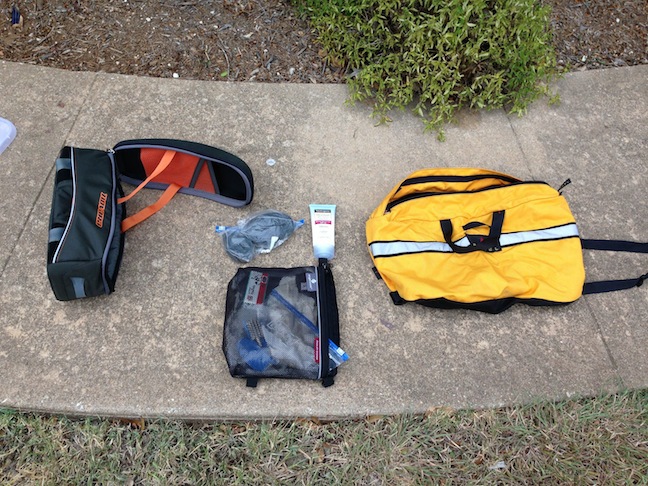
|
Put the seat bag on the back of the P-38

|
Of course when I went to go for a ride I remembered that I also needed to:
One of the things you read about the F-40 in high wind environments is the technique of sticking your elbow out on the windward side.
Performing this technique requires that first the bike adjusted correctly.
Before purchasing my F-40 I asked many questions on BROL (BentRiderOnline.com) about correct positioning of hands, feet, boom, etc. and I got answers all over the map.
Looking at pictures of P-38 and F-40 setups on the web I again saw different hand/arm positions.
Basically, the question is: “Should the arms be straight like on a stick bike, or should the arms have a 90 degree angle bend at the elbow?”
The web pictures of the P-38 were split about 50/50 between straight and bent. The very vast majority (like 99%) of the F-40 pictures showed the arm bent underneath the spandex cover.
When I initially started riding my F-40 without the cover (ie a P-38) I leaned the seat back as much as possible to improve aerodynamics - this caused my arms to be straight.
Here is a picture of the initial P-38 arm position.
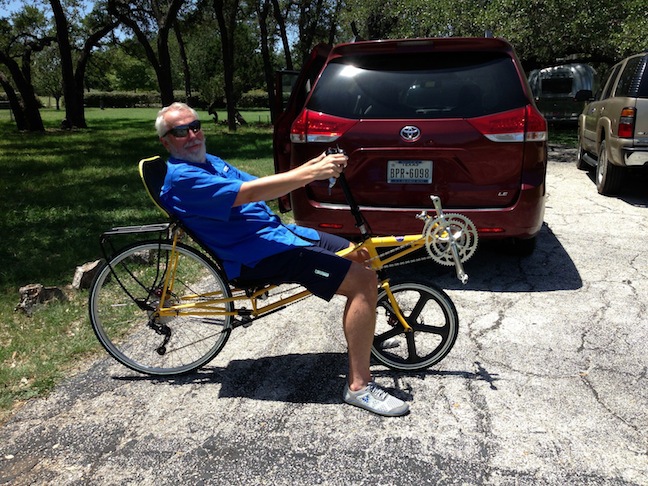
Putting the fairing on the P-38 to turn it into an F-40 turned out to be an issue with having the seat so reclined. Basically, in order to get the tail frame to attach to the back of the seat while also being horizontally aligned with the stays and rear derailleur required me to adjust the seat angle to the most upright position possible. If the seat is reclined at all the rear deraileur bangs into the tail frame when changing through specific gear combinations.
Here is a picture of the seat in the most upright position on the F-40. Notice that the arm position now has the elbow bent at 90 degrees (like 99% of all other pictures of F-40s on the web).

This 90 degree elbow angle turns out to be a requirement when implementing the wind gust negating maneuver of sticking your elbow out on the windward side.
Lets say that the wind is coming from your left when riding. Then the front quarter windward view looks like this:

In this position when a wind gust hits the bike the spandex stretches inwards creating a shallow bowl, thereby capturing as much wind as possible, maximizing the effects of the gust, causing the wind to significantly shove the bike to the right.
After some riding you will begin to anticipate when a gust is potentially going to happen. Breaks in houses, breaks in trees, valley at bottom of a hill, when a guard rail ends, etc., etc.. It is important when first learning to ride the F-40 that you keep the speed down below 20 mph so that you can learn to anticipate the gusts without getting blown significantly around the road in the process.
When you think a gust is going to happen rotate your elbow from the pointing down position to the sticking out to the side position - like this:
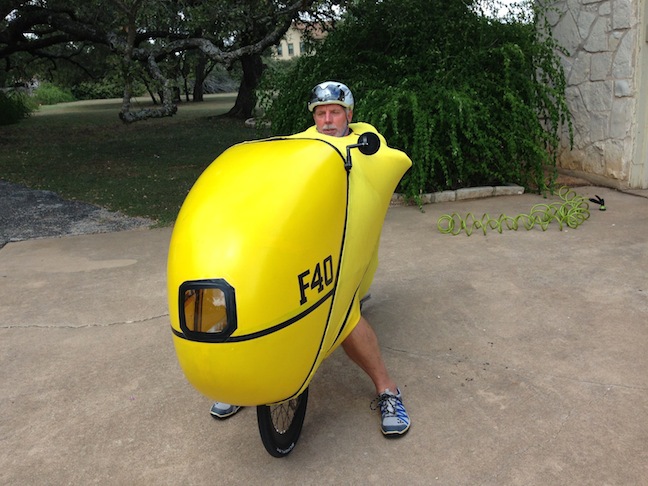
This actually does two things: 1) stops the spandex from being able to stretch inwards, and 2) causes a low pressure (venturi) effect on the windward side which helps the bike negate the coming gust.
There does not seem to be a penalty to just having your elbow stick out for no reason (outside of your arm getting tired). A lot of times if I know a gust is coming, but I not sure from which direction, I’ll stick out both elbows.
Here is another side view of the elbow sticking out - you can see the position of the elbow but it is really hard in this view to understand how far the elbow is really sticking out (ie as far as you possibly can).
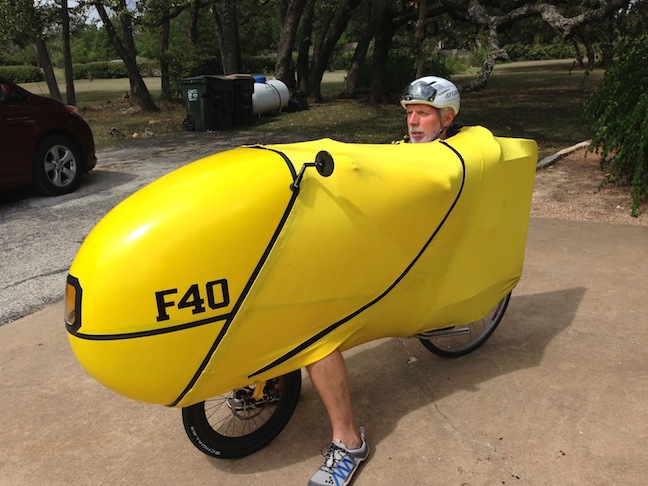
The F-40 really is a different bike. I have ridden it in winds of 22 mph gusting to 28 - it is doable but very intense.
Just a nice easy ride today enjoying the weather. Ronald Reagan is now paved all the way from Williams to IH35 (although not all sections are yet open to cars).
Photo from Bike ride this morning taken where Ronald Reagan meets IH35 looking back south on the new part of Ronald Reagan. What a view.
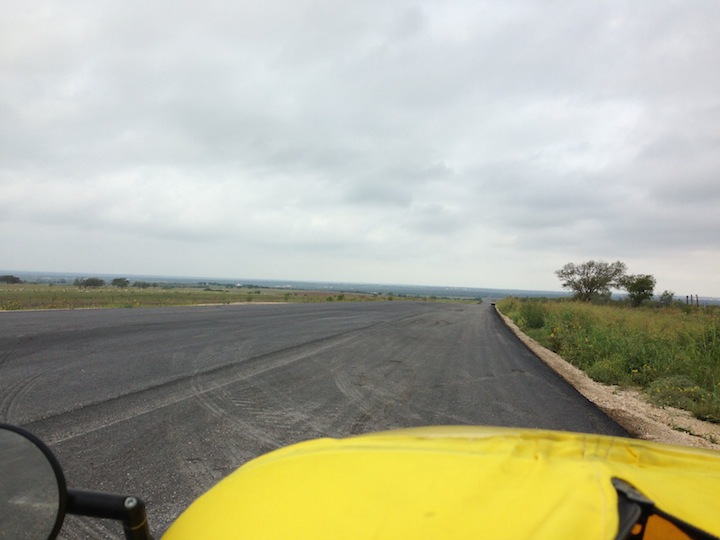
http://app.strava.com/activities/82637141
Today was a good day - 47.3 miles at 20.6 mph.
If I would have pushed it a little bit more then today I probably could have done 50 miles at greater than 20 mph.
I have a couple of goals:
There are a few recumbent riders in the area that are at or above these performance goals:
The first goal of 25 miles at 25 mph is to attack my Functional Threshold Power (FTP). This I am doing by riding intervals 2 or 3 times a week.
The Engine
Weekly strategy:
I also need to lose 25 pounds body weight. I have drastically altered my diet to be more fruits, vegies and non-processed food. Started to get serious about the belly because with the P-38 (F-40) my belly keeps flopping on my legs as I peddle.
The Bike
I ordered a new rear wheel that is a deep-v carbon clincher rim like I have on the Musashi. This should give better aero performance. It should be here in about a month.
The 100 oz camelbak is not working out. With the longer rides the ice in the camelbak is melted within 2 hours. I’ll probably end up going back to the growler.
Ride Strategy
Every ride now it seems like I get at least 1 one-mile split time that is greater than 30 mph. Today I had one at 30.6 mph and I had 4 splits that were in the 29 to 29.9 mph range.
It takes forever to accelerate to 30, but once there it is easy to hold on level ground. I need to really work on the accleration. It is probably related to shifting quickly and precisely into the 60 tooth front chainring. I can get to 25-26 mph quickly by just staying in the middle front chainring.
Started out just being a nice easy long ride.
Ten miles into the ride I turned north on Ronald Reagan (RR) with a tandem about 1/2 mile in front of me. Caught them pretty quickly and then proceeded to catch rider after rider. At the 15 mile turn around point I decided to continue across FM195 and then north on RR for another 5 miles on the newly paved (but not yet open to cars) section.
At the 20 mile turn around point was averaging 20.6 mph and decided to push it to keep up my average speed on the way back
At the 30 mile mark (intersection of RR and 2338/Williams) I noticed a big group turning around at the corner and heading back to NW Austin south on RR. So, I rested 5 minutes while they got somewhat ahead and then proceeded to do the next 3.5 miles at 30 mph until I had passed them all. What fun.
http://app.strava.com/activities/82357215
On the Musashi, or Baron, if while riding I increased my speed to 20+ mph I was happy. And if the speed increased to 24+ mph I was really happy.
Well, this turns out to be a mental block with the F-40.
New rule: If I increase my speed to 25+ mph then I’ll be happy. And if the speed increases to 30+ mph then I’m really happy.
Beautiful morning for a bike ride - just enjoying the scenery.
Kept the heart rate really low and still averaged 19.0 mph.
